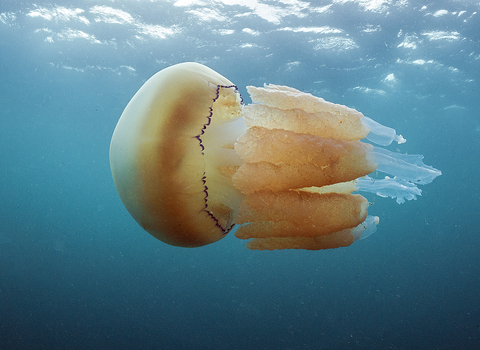
Barrel jellyfish ©marknthomasimages.co.uk
Barrel jellyfish
Scientific name
Rhizostoma pulmoWhen to see
May to OctoberSpecies information
About
These large jellyfish swarm in warmer coastal waters in late spring and often wash up on our beaches in May or June, sometimes in their hundreds. Their favourite meal is plankton, which can be found in shallow waters. This is what often causes them to wash up, as they underestimate their size. They have eight frilly arms, which contain their small stinging tentacles and surround hundreds of little mouths! The sting of the barrel jellyfish is not normally harmful to humans, though if you find one on the beach it's best not to handle it as they can still sting when dead.How to identify
A large translucent jellyfish with a huge mushroom shaped bell and a bunch of 8 frilly tentacles below. They don't have marginal tentacles but do have a violet fringe around the bell which contains sense organs. They are often found washed up on beaches in May and June.Distribution
Common off Southern and Western coasts of Britain in summer months.In our area
Eight jellyfish species have been recorded throughout Dorset with frequent sightings of the compass, moon, blue and barrel jellyfish in the spring and summer. On occasion, these have included swarms.
The barrel jellyfish is one of the largest we see in Dorset. Odd sightings of these have occurred over the last few decades but this changed in May 2014, when swarms appeared along the South Coast. Similar numbers have been reported throughout spring and summer 2015.
Barrel Jellyfish, which grow up to an impressive 1 metre wide and weigh 25kg, can give a mild sting, even when dead. Dorset Wildlife Trust (DWT) is advising members of the public not to touch any jellyfish they find and to send in photos of the sighting. These are essential to aid identification particularly as jellyfish change colour, shape and size when stranded.
Jellyfish swarms could entice more marine life
The leatherback turtle and the oceanic sunfish have been known to visit Dorset. Whilst confirmed sightings of the leatherback are uncommon, sunfish are often reported in the summer. Both of these species are attracted to the South Coast in pursuit of their favourite food. An increase in jellyfish numbers is likely to improve the chance of seeing these impressive megafauna and averaging at 2m in length, that would be quite a sighting. Keep your eyes peeled!
Health & safety
Please remember to look but don't touch - jellyfish are capable of stinging even when stranded dead on the shore. Remember to keep dogs away too. Some species such as the Portuguese man o'war are known to cause a painful sting but are rarely deadly.
If you have been stung by a jellyfish, seek medical advice! The NHS provide full details on the prevention, symptoms and treatment of a jellyfish sting HERE.
Identify your jellyfish sighting
See Dorset's jellyfish on this downloadable guide.
Report your sighting
Tweet us your sightings and photos using the hashtag #dorsetjellyfish or contact us on Facebook. You can also email us at kimmeridge@dorsetwildlifetrust.org.uk
Did you know?
Barrel jellyfish are the favourite food of leatherback turtles, the world's largest sea turtle.Watch
Eight jellyfish species have been recorded throughout Dorset with frequent sightings of the compass, moon, blue and barrel jellyfish in the spring and summer. On occasion, these have included swarms.
The barrel jellyfish is one of the largest we see in Dorset. Odd sightings of these have occurred over the last few decades but this changed in May 2014, when swarms appeared along the South Coast. Similar numbers have been reported throughout spring and summer 2015.
Barrel Jellyfish, which grow up to an impressive 1 metre wide and weigh 25kg, can give a mild sting, even when dead. Dorset Wildlife Trust (DWT) is advising members of the public not to touch any jellyfish they find and to send in photos of the sighting. These are essential to aid identification particularly as jellyfish change colour, shape and size when stranded.
Jellyfish swarms could entice more marine life
The leatherback turtle and the oceanic sunfish have been known to visit Dorset. Whilst confirmed sightings of the leatherback are uncommon, sunfish are often reported in the summer. Both of these species are attracted to the South Coast in pursuit of their favourite food. An increase in jellyfish numbers is likely to improve the chance of seeing these impressive megafauna and averaging at 2m in length, that would be quite a sighting. Keep your eyes peeled!
Health & safety
Please remember to look but don't touch - jellyfish are capable of stinging even when stranded dead on the shore. Remember to keep dogs away too. Some species such as the Portuguese man o'war are known to cause a painful sting but are rarely deadly.
If you have been stung by a jellyfish, seek medical advice! The NHS provide full details on the prevention, symptoms and treatment of a jellyfish sting HERE.
Identify your jellyfish sighting
See Dorset's jellyfish on this downloadable guide.
Report your sighting
Tweet us your sightings and photos using the hashtag #dorsetjellyfish or contact us on Facebook. You can also email us at kimmeridge@dorsetwildlifetrust.org.uk
